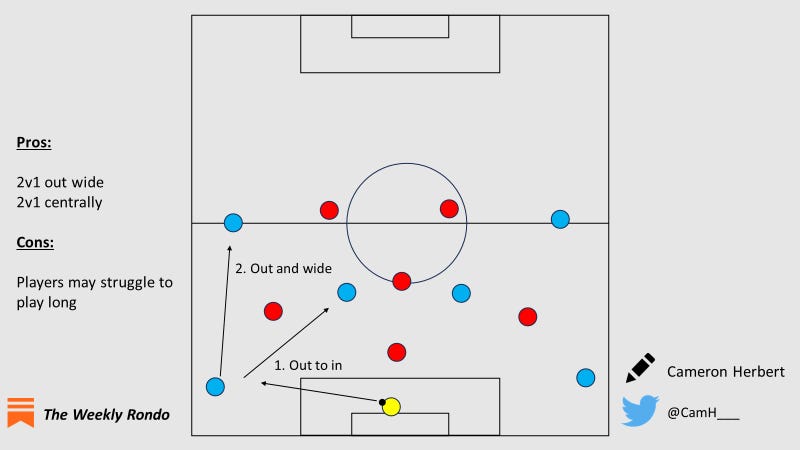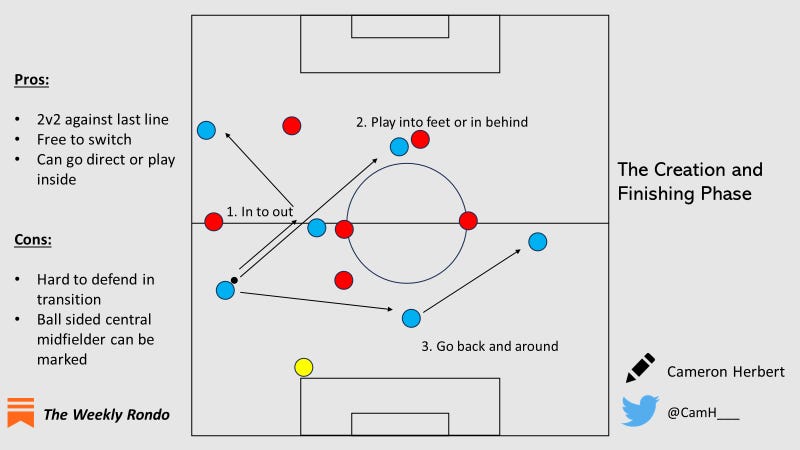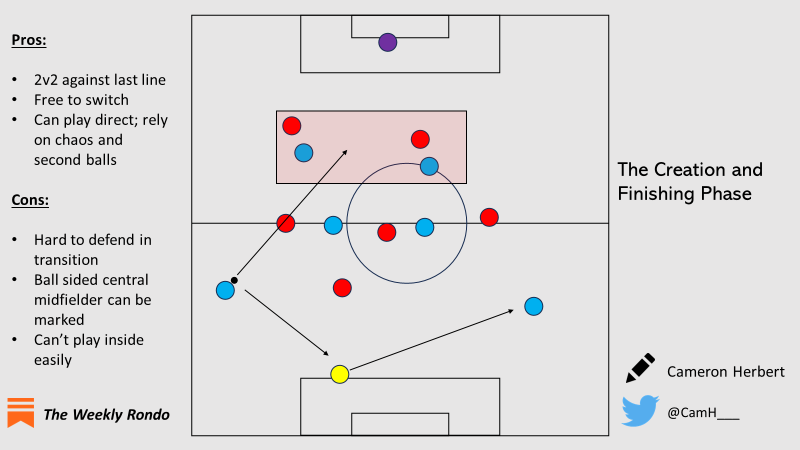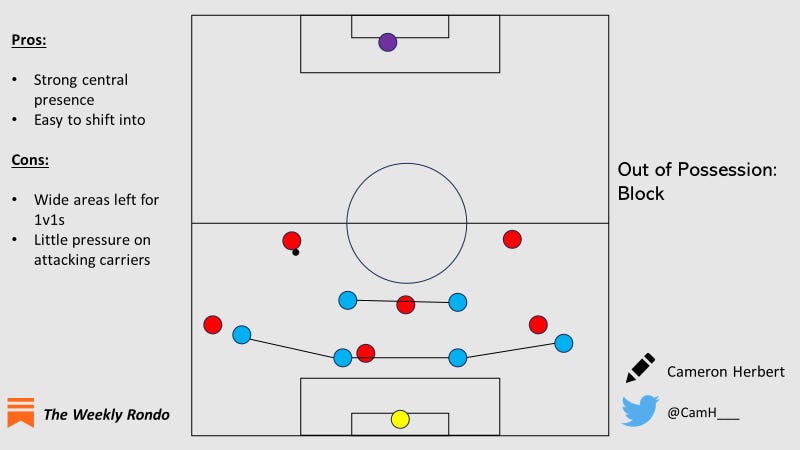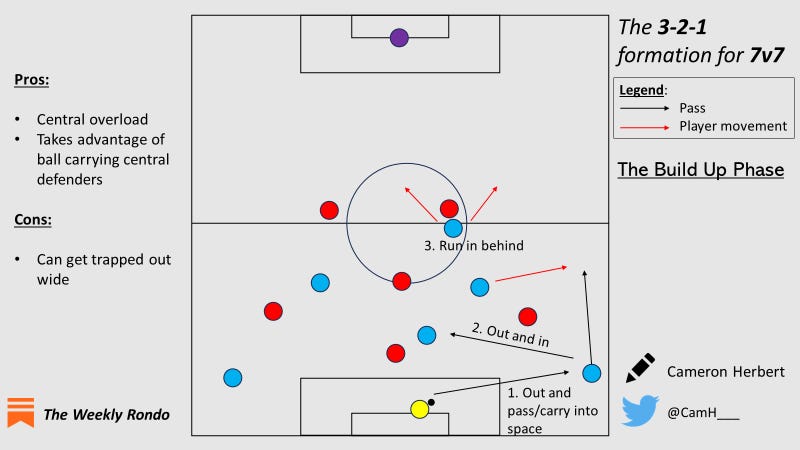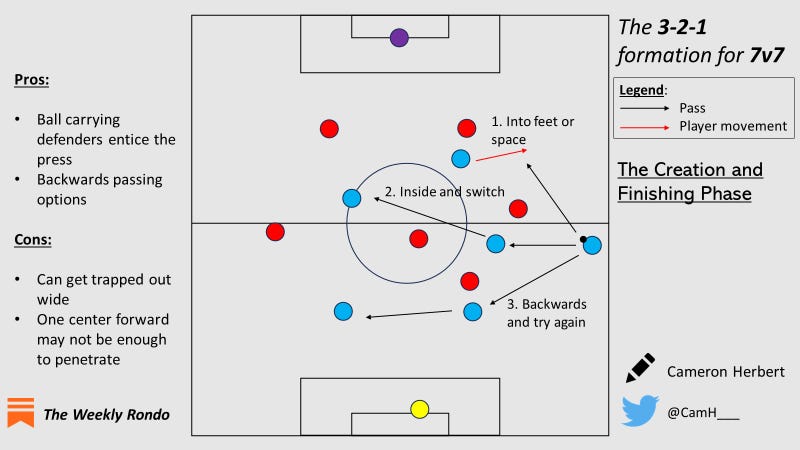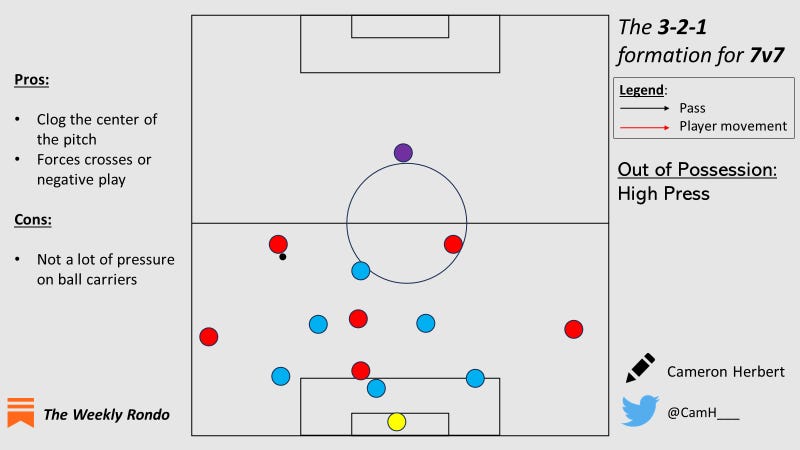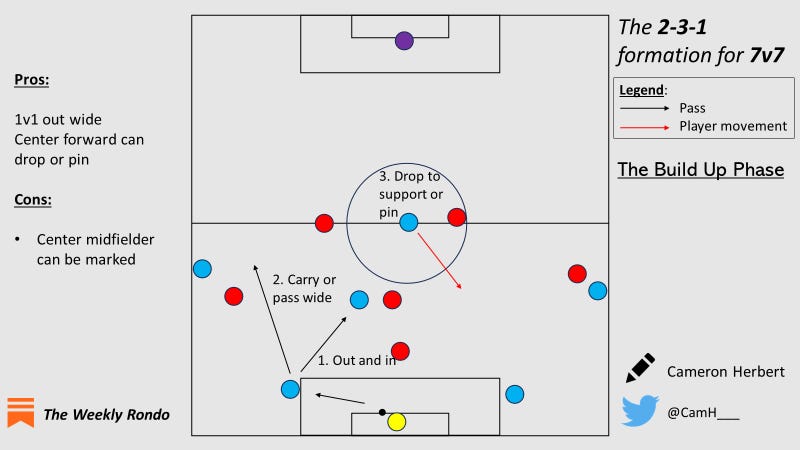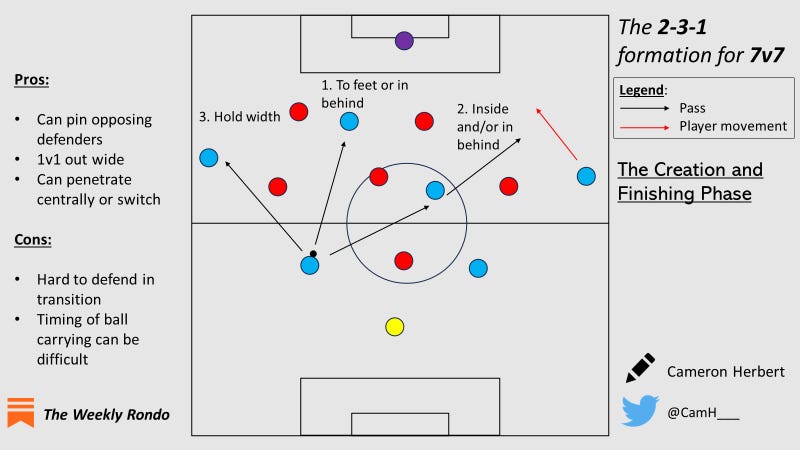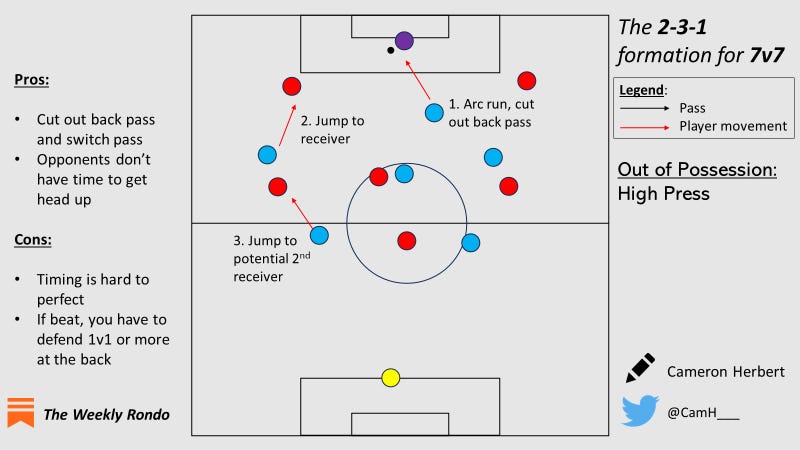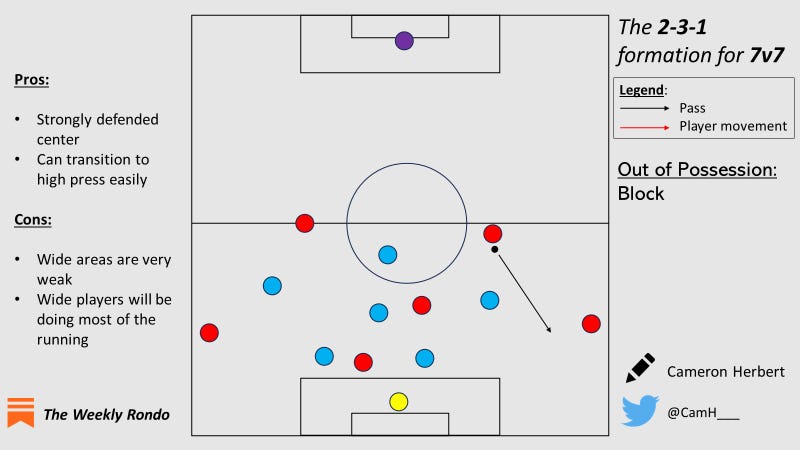7v7 is mostly used in youth football for players between the ages of 8-13.
Nonetheless, we have three formations and tactical ideas that you can use depending on your game model and desired outcomes for your players.
2-2-2
3-2-1
2-3-1
Before we continue, hit the “heart” button so that more people see this newsletter. I don’t like asking for “likes” but it’s the best way to grow The Weekly Rondo.
What’s your favorite 7v7 formation?
2-2-2
This formation should be used if you plan on developing players in a system with two central forwards and two central pivot players. Ideally, this builds into a 4-4-2 or 4-2-2-2 system.
When the players move to 9v9 we can add full-backs, making this a 4-2-2 with the same ideas we’ll discuss for 7v7.
In possession:
Build Up:
The defenders being wide will be a recurring theme in all of our formations. This is to allow the goalkeeper to get involved in build up. However, with the 2-2-2 a lot of the width in build up will come from the central defenders.
The midfielders will remain central similar to how they might in a traditional 4-4-2 and 4-2-2-2.
Width will be provided by the two central forwards. Their starting position may resemble wingers, but once the ball is moving they will be free to move appropriately in response to the defending team, ball, and their teammates.
Creation and Finishing:
Once you’ve beaten the first line of the press we can explore the possible rotations.
One of the central forwards can move centrally while the other remains on the same side as the ball so as to pin an opposing defender while also providing width.
The pivot players react similarly to the central forwards with the key difference being that one of them remains wider than the central defender furthest from the ball so that your team can switch play if needed.
Against a two defender system the opponent will feel pressured to mark both central forwards tightly. Youth players aren’t comfortable working in a more zonal environment nor are they playing against two forward systems very often - most academy philosophies have their youth teams playing with one forward.
Out of Possession:
This style of play resembles the famous “Red Bull” brand of football and therefore requires athletic players, or players who are able to understand how pressing works.
High Press:
This system uses a man oriented defending system when defending high up the pitch. One central forward presses the ball carrier while the other marks the nearest passing option.
The other four defenders are free to mark other defenders.
Mid/Low Block:
During periods of settled possession, the 2-2-2 can turn into a 4-2 with the wide forward players adopting the natural fullback roles, or with the pivot players adopting central defender roles and the central defenders moving out wide
Pros:
Two forwards
Direct
Favors athleticism
Exciting high press
Cons:
Poor defending in transition
Favors athleticism
3-2-1
This formation is flexible and a favorite amongst coaches who work in more flexible environments.
It can be used in a game model preparing for players to play in a 3-4-3 or just as easily a 4-3-3. The differences are subtle with the center-central defender either moving into a holding midfielder role in a 4-3-3 or remaining as a center-central defender in a 3-4-3.
All that gets added are the fullbacks/wingbacks and wingers.
In Possession
Build Up:
The widest defenders go wide while the center-central defender higher up the pitch, remaining central, so that you have someone to receive centrally.
The two central midfield players can stay in the half-spaces, providing some width but relying on the wider central defenders to create the most width.
The center forward can either pin the defending central defender or drop deeper into midfield to act as the central receiver if the center-central defender can’t receive alone. The downside could be that there is now no pressure against the opponents back line.
Creation and Finishing:
The ball sided wide central defender can add width similar to how a winger or fullback might, while the other two defenders slide across.
The center-central defender now rejoins the backline and forms a pseudo back two in possession to allow the other defender to go forward.
The ball sided midfield option can combine with the ball sided defender while the center forward looks to run in behind or move to receive.
Out of Possession
High Press:
With one forward the two midfield players will need to be willing to jump or mark based off of the movement of the forward.
Against a two player defense, the center forward will force play to one side while the ball sided defender jumps to the closest passing option while the central midfielders covers the inside passing option.
Mid/Low Block:
This is one of the safest formations to use when defending in 7v7 because the goals are so small and the space that three central defenders can cover with two midfielders screening is easy.
Opponents will have a very hard time scoring and will likely be reduced to moments of individual brilliance or long shot/low probability methods of chance creation.
Pros:
Flexible for different game models
Great defense
Easy combinations
Cons:
Zonal defending understanding needed
“Park the bus” situation when first line of press is beaten
2-3-1
This formation is the most natural predecessor to the 4-3-3. In 9v9 it becomes a 4-3-1 or 2-3-3. The positions and responsibilities are quite clear whereas the 3-2-1 isn’t rigid in the responsibilities it requires to be playable.
In Possession
Build Up:
Central defenders should go wide but not as wide as the 3-2-1. Here, they will remain in the half-space while the two widest players in midfield add the most width and the central midfield player is able to receive in the middle of the pitch.
This is best used when you have natural wingers or full backs in your group, whereas the 3-2-1 or even 2-2-2 is best when you have strong ball carrying defenders.
Creation and Finishing:
The wingers will drag the defenders wide. The center forward can make a run in behind or move in order to combine with the ball sided wide player.
The central midfield player will act as a lone pivot, able to receive with the idea of carrying, penetrating or switching.
Out of Possession
High Press:
Similar to the 2-3-1 in that the lone center forward guides the press, the difference here is that the ball sided wide player can jump to the ball carrier while the center forward arcs their run to cover sideways or backwards passing options.
This forces the ball carrier to continue carrying or play a long ball over the top to avoid losing the ball.
Mid/Low Block:
The center forward can guide the press still, however the wide players should be more reluctant to jump because of the space left behind them. When defending, these wide players suffer the same problems as very aggressive fullbacks in that they leave space behind them for their central defender to cover.
It’s best to air on the side of caution here and have the center forward guide the direction of the block but ask the wide players to jump less on the ball carrier.
Pros:
Great for wingers and fullbacks
Exciting high press
Cons:
Space behind widest players
Conclusion
The value we can get from formations at youth level comes from how well the players are prepared for the older age groups.
If your game model favors a certain type of player over another, your formation and coaching points need to reflect that in order to best prepare your players.
When it comes to choosing which formation to use, look at what your academy or club is playing at its oldest age group and work from that.
If you enjoyed this, consider referring a friend to earn a free subscription!





